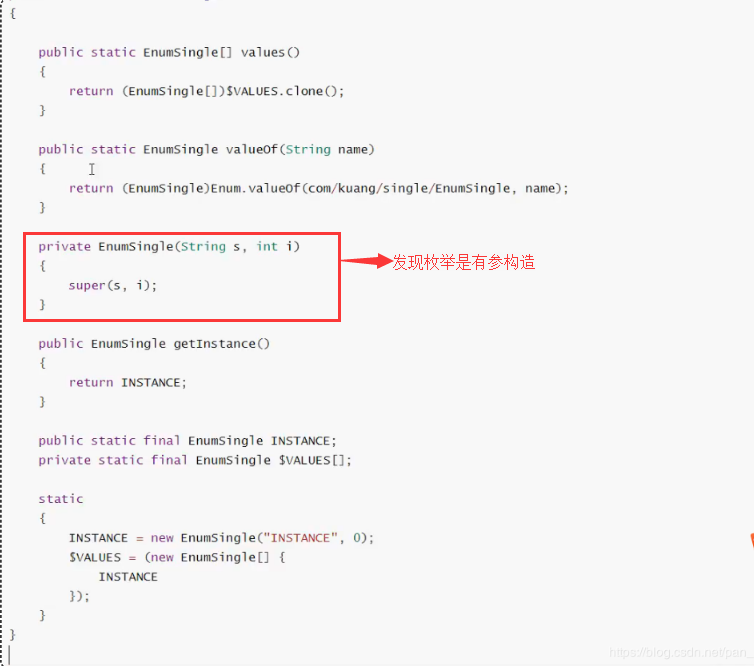单例模式
饿汉式:
package cn.tedu.single;
//饿汉式单例
public class Hungry {
private Hungry(){
}
//会造成空间的浪费,开辟了空间,却没有使用
private final static Hungry HUNGRY= new Hungry();
public static Hungry getInstance(){
return HUNGRY;
}
}
懒汉式:
存在多线程并发模式,后面的DCL懒汉式解决并发问题
package cn.tedu.single;
//懒汉式
public class LazyMan {
private LazyMan(){
System.out.println(Thread.currentThread().getName()+"ok");
}
private static LazyMan lazyMan;
//双重检测锁模式的懒汉式单例 DCL懒汉式
public static LazyMan getInstance() {
if (lazyMan==null){
if (lazyMan==null){
lazyMan= new LazyMan();//不是一个原子性操作
}
}
return lazyMan;
/*
* 1.分配内存空间
* 2、执行构造方法,初始化对象
* 3、把这个对象指向者个空间
*
* 123(期望的执行顺序)
* 132 A(实际的执行顺序)
* B //此时lazyMan还没有完成构造
* */
}
////多线程下会有问题
public static void main(String[] args) {
for (int i=0;i<5;i++){
new Thread(()->{
lazyMan.getInstance();
}).start();
}
}
}
DCL懒汉式:双重检测锁模式的懒汉式单例
注意:synchronized 解决并发问题,但是因为lazyMan = new LazyMan();不是原子性操作(可以分割,见代码注释),可能发生指令重排序的问题,通过volatil来解决
- Java 语言提供了volatile和 synchronized两个关键字来保证线程之间操作的有序性,volatile 是因为其本身包含“禁止指令重排序”的语义,synchronized 是由“一个变量在同一个时刻只允许一条线程对其进行 lock 操作”这条规则获得的,此规则决定了持有同一个对象锁的两个同步块只串行执行。
- 原子性就是指该操作是不可再分的。不论是多核还是单核,具有原子性的量,同一时刻只能有一个线程来对它进行操作。简而言之,在整个操作过程中不会被线程调度器中断的操作,都可认为是原子性。比如 a = 2;
package cn.tedu.single;
//懒汉式
public class LazyMan {
private LazyMan(){
System.out.println(Thread.currentThread().getName()+"ok");
}
//使用关键字
private volatile static LazyMan lazyMan;
//双重检测锁模式的懒汉式单例 DCL懒汉式
public static LazyMan getInstance() {
if (lazyMan==null){
synchronized (LazyMan.class){//锁类
if (lazyMan==null){
lazyMan= new LazyMan();//不是一个原子性操作
}
}
}
return lazyMan;
/*
* 1.分配内存空间
* 2、执行构造方法,初始化对象
* 3、把这个对象指向者个空间
*
* 123(期望的执行顺序)
* 132 A(实际的执行顺序)
* B //此时lazyMan还没有完成构造
* */
}
////多线程下会有问题
public static void main(String[] args) {
for (int i=0;i<5;i++){
new Thread(()->{
lazyMan.getInstance();
}).start();
}
}
}
静态内部类
package cn.tedu.single;
//通过内部类
public class Inner {
//构造器私有
private Inner(){
}
public static Inner getInstance(){
return InnerSon.inner;
}
public static class InnerSon{
private static Inner inner = new Inner();
}
}
单例不安全,反射可以破坏(见注释及main方法中反射破解步骤)
package cn.tedu.single;
import java.lang.reflect.Constructor;
import java.lang.reflect.Field;
//单例不安全可以通过反射破环
public class Lazy {
//设置标记
private static boolean flag =false;
private Lazy(){
synchronized (Lazy.class){
if (flag==false){
flag=true;
}else {
throw new RuntimeException("不要试图使用反射破环单例");//但是可以通过设置标记的布尔值
}
}
System.out.println(Thread.currentThread().getName()+"OK");
}
private volatile static Lazy lazy ;
public static Lazy getLazy() {
synchronized (Lazy.class){
if (lazy==null){
lazy=new Lazy();
}
}
return lazy;
}
public static void main(String[] args) throws Exception {
// Lazy lazy = Lazy.getLazy();
Field flag = Lazy.class.getDeclaredField("flag");
flag.setAccessible(true);
Constructor<Lazy> declaredConstructor = Lazy.class.getDeclaredConstructor(null);
declaredConstructor.setAccessible(true);
Lazy lazy1 = declaredConstructor.newInstance();
flag.set(flag,false);
Lazy lazy2 = declaredConstructor.newInstance();
System.out.println(lazy1);
System.out.println(lazy2);
//仍然可以创建多个实例,道高一尺,魔高一丈
}
}
枚举:通过反射破解枚举发现不成功:
1、普通的反编译会欺骗开发者,说enum枚举是无参构造
2、实际enum为有参构造(见后面);
3、通过反射破解枚举会发现抛出异常
Exception in thread "main" java.lang.IllegalArgumentException: Cannot reflectively create enum objects at .....
package cn.tedu.single;
import java.lang.reflect.Constructor;
//enmu是什么?本身也是一个class类
public enum EnumSingle {
INSTANCE;
public EnumSingle getInstance(){
return INSTANCE;
}
}
class Test{
public static void main(String[] args) throws Exception {
EnumSingle instance = EnumSingle.INSTANCE;
Constructor<EnumSingle> declaredConstructor =
EnumSingle.class.getDeclaredConstructor(String.class,int.class);// null java.lang.NoSuchMethodException:
declaredConstructor.setAccessible(true);
EnumSingle instance1 = declaredConstructor.newInstance();
System.out.println(instance);
// Cannot reflectively create enum objects
System.out.println(instance1);
}
}
通过idea和jdk自带的反编译枚举如下:

通过jad反编译枚举的代码如下
